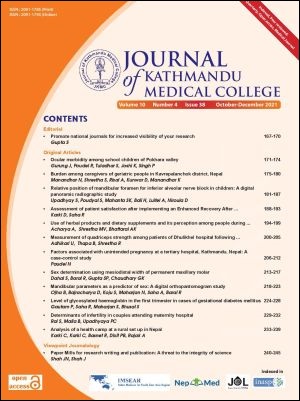Measurement of quadriceps strength among patients of Dhulikhel hospital following anterior cruciate ligament reconstruction: A descriptive cross-sectional study
DOI:
https://doi.org/10.3126/jkmc.v10i4.43861Keywords:
Anterior cruciate ligament injuries, Anterior cruciate ligament reconstruction, Muscle strength, RehabilitationAbstract
Background: Anterior cruciate ligament is the key structure of the knee joint. Quadriceps weakness in the involved leg is frequently seen in the rehabilitation setting even when an individual returns to their functional activity.
Objectives: To measure the quadriceps strength following an anterior cruciate ligament reconstruction and evaluate the functional activity level.
Methods: An analytical cross-sectional study was conducted among 30 anterior cruciate ligament reconstruction patients visiting physiotherapy outpatient department of Dhulikhel hospital between 2nd May 2019 to 4th May 2020. Nonprobability purposive sampling was used for the study. Participants with a history of primary unilateral anterior cruciate ligament reconstruction no less than six months were recruited for the study. Study excluded other lower limb surgeries, anterior cruciate ligament reinjury, multiligament injury, and pregnant women. Quadriceps muscle strength was assessed by using a handheld dynamometer, MicroFET2 and functional activity level with Lysholm scale. Independent sample t-test was done to assess the association between quadriceps strength and different variables.
Results: Quadriceps strength deficit in an involved limb was 17.5% and mean length physiotherapy follow up was 11.7 ± 5.9 days in six months. Quadriceps strength was significantly different between genders. There was no statistical significance between quadriceps strength and body mass index. Higher quadriceps strength had greater levels of function.
Conclusion: Quadriceps strength deficit was found after anterior cruciate ligament reconstruction. Functional activity was affected even after an individual returned to their normal daily activities.
Downloads
Downloads
Published
How to Cite
Issue
Section
License
Copyright © Journal of Kathmandu Medical College
The ideas and opinions expressed by authors or articles summarized, quoted, or published in full text in this journal represent only the opinions of the authors and do not necessarily reflect the official policy of Journal of Kathmandu Medical College or the institute with which the author(s) is/are affiliated, unless so specified.
Authors convey all copyright ownership, including any and all rights incidental thereto, exclusively to JKMC, in the event that such work is published by JKMC. JKMC shall own the work, including 1) copyright; 2) the right to grant permission to republish the article in whole or in part, with or without fee; 3) the right to produce preprints or reprints and translate into languages other than English for sale or free distribution; and 4) the right to republish the work in a collection of articles in any other mechanical or electronic format.




